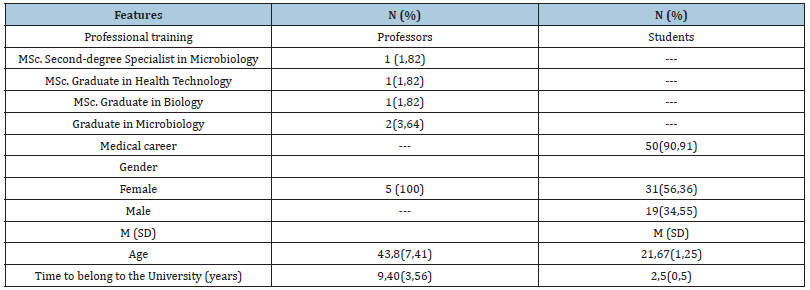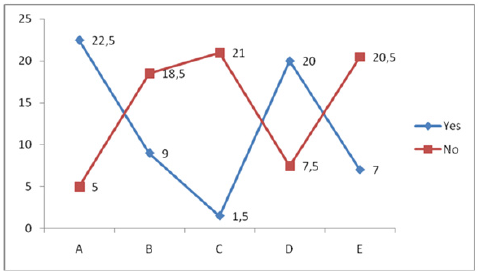- Submissions

Full Text
Cohesive Journal of Microbiology & Infectious Disease
Level of Knowledge of the Academic Medical Community about Nanotechnology-Based Strategies Developed to Manage Infectious Diseases: A Short Study
Garcia LS*
University of Medical Sciences, Cuba
*Corresponding author: Lourdes Serrano Garcia, University of Medical Sciences, Cuba
Submission: July 19, 2021; Published: August 11, 2021

ISSN 2578-0190 Volume5 issues3
Abstract
Nanotechnology is an interdisciplinary research field that integrates chemistry, engineering, biology, and medicine. Several useful nanotechnological applications have been identified in cancer biology, including technologies for the early detection of tumors and cancer biomarkers, and the development of treatment approaches that are impossible to achieve using conventional technologies as demonstrated during the current COVID-19 pandemic, nanotechnology can play a major role in global health. From better screening and diagnostics to therapeutics and vaccines, as well as health monitoring devices, nanotechnologyenabled approaches have the potential of making a tangible impact in the field of infectious diseases. In the area of prevention and treatment of infection, it has been proposed that materials not only be used by professionals (such as during infection treatment by clinicians in hospitals) but also by every person (such as nanoparticles in paints for use at home or over the counter nanodrugs). For this reason, future work must rely on collaboration among engineers, clinicians, and environmental scientists (and those from other fields as well) to fully characterize such nanomaterials in terms of chemistry, impurities, and toxicity. With the establishment of safe usage guidelines, nanomaterials can be safely used for the important and growing area of antimicrobial material design. We should be excited (not frightened) about what the future holds for nanotechnology in these collaborative anti-infection efforts. Despite being a rapidly expanded field of research, the advances of Nanotechnology continue to be largely unknown. Specifically referring to infectious diseases, it would be interesting to explore the level of knowledge of the academic medical community about the contribution of this multidisciplinary science to their prevention and control, which constitutes the main objective of this study
Keywords:Academic medical community; Nanotechnology; Infectious diseases
Introduction
Nanotechnology, with the improvement and application of the nanoparticles (NPs)/ nanocarriers with dimension in the nanoscale range (1~100 nm) has been widely utilized in a variety of fields, that integrates chemistry, engineering, biology and medicine. The extremely small size of NPs allows efficient entrance into living system such as animal and human body. Furthermore, the strong encapsulation effect of NPs protects the materials until delivered to the target sites. The field is evolving, and it has gained public and media interest worldwide [1]. As demonstrated during the current COVID-19 pandemic, nanotechnology can play a major role in global health [2,3]. From better screening and diagnostics to therapeutics and vaccines, as well as health monitoring devices, nanotechnology-enabled approaches have the potential of making a tangible impact in the field of infectious diseases [4]. Despite being a rapidly expanded field of research, the advances of Nanotechnology continue to be largely unknown [5]. Specifically referring to infectious diseases, it would be interesting to explore the level of knowledge of the academic medical community about the contribution of this multidisciplinary science to their prevention and control, which constitutes the main objective of this study.
Material and Method
A brief exploratory study was conducted via WhatsApp under a descriptive cross-sectional design at the University of Medical Sciences of Holguin province, Cuba, during June 2021. The study universe included all second-year students of the Medicine career and the 20 professors of the Medical Microbiology and Parasitology subject. The selection of the sample was intentional and consisted of: a) 50 second-year students who take the course in the semester mode (of which repeaters were excluded, students who do not reside in the Holguin municipality and those who maintain a frequency of lowest communication via WhatsApp (less than four days/week); and b) 5 professors with more than 9 years of teaching experience in the department who are teaching the subject in the distance mode and who are responsible for the scientific-methodological update of the subject. A questionnaire-type instrument was applied, treated voluntarily, anonymously and confidentially. The survey was constructed based on 3 variables that were explored through 25 items. The distribution to obtain information from the participants was as follows: demographic data (4 items); general questions about the use of Nanotechnology in biomedical research and clinical practice (10 items); didactic-methodological issues related to the teaching-learning of Nanotechnology contents in the subject (6 items); nanotechnology-based strategies developed to control infectious diseases (5 items). The items were classified in nominal and ordinal form. Nominals were measured dichotomously (for 2 categories) and categorically (for 3 or more categories); ordinals in various categories. For data collection, some of the scales to measure attitudes, suitable for social science research, were used, such as: the Likert scaling method [6] and the semantic differential method [7]. Because the present work has an informative and descriptive purpose of the knowledge of the participants, the results were not subjected to comparisons or additional statistical procedures were carried out to the measures of central tendency (M) and standard deviation (SD). The subjects involved were presented with the research objectives, the selection criteria and the questionnaire that they had to complete. Data was collected on the same day. The research was approved by the Research Ethics Committee of the University of Medical Sciences of Holguin, the ethical standards of the Research Committee and the Declaration of Helsinki of 1975, revised in October 2000, were met.
Result
The characteristics of the study participants are described in Table 1, the opinions regarding the aspects examined were expressed in percentages and averages, in the manner previously described. After processing the surveys applied to the students, it was determined the importance that they give to the teachinglearning of the contents related to Nanotechnology in their professional training. The 100% of them considered that the subject Medical Microbiology and Parasitology only potentiates in a “medium level” the formative integration of said contents in the Medicine career. The same percentage agreed on the fact that this theme is essential for the development of modes of student action that are expressed in future performances that respond to the demands of contemporaneity. For their part, all the teachers opted for the “totally agree” variant when issuing their criteria on the need to improve the dynamics of the subject in this direction. Regarding the self-assessment made by both groups of participants (teachers and students) on the level of knowledge achieved in relation to general questions about the use of Nanotechnology in biomedical research and clinical practice, (Figure 1), the predominance of a maximum value in the figures referred to the level ¨medium knowledge¨, followed by the alternative ¨ low knowledge¨. It is interesting to highlight the similarity perceived in the nullity of the selection of the qualifier “high knowledge”. As can be seen in Figure 1, the knowledge of the subjects involved in this research is less in terms of the following aspects: ¨Microbiological benefits¨ (25,45%), ¨Nanotechnology strategies¨ (25,45%) and ¨Recent advances ¨ (29,09%), which indicates the imminent need to update these issues in particular.
Table 1: Socio-occupational characteristics of the participating subjects

Figure 1:Percentage values of the data obtained referring to the level of knowledge that prevailed, according to the selection of the participants.

In relation to the opinions regarding the knowledge of nanotechnology-based strategies developed to control infectious diseases, a coincident and high inclination towards the selection of the “No” answer was evidenced in each of the alternatives (Figure 2). It is noteworthy that the calculated means show higher values towards the ignorance of characteristics such as ¨ Strategies for pathogens tracking and monitoring¨ and ¨Efficiency of vaccines based on Nanotechnology ¨, which constitutes a regrettable finding.
Figure 2:Evaluations carried out by the participating subjects in relation to the level of knowledge reached about nanotechnology-based strategies developed to control infectious diseases, according to average. Categories: A): Infectious diseases where Nanotechnology has been used; B): Strategies for pathogens tracking and monitoring; C): Efficiency of vaccines based on Nanotechnology; D): Appreciation of the socio-cultural-environmental context where Nanotech innovations should be applied; E): Adaptation of Nanotechnology protocols to the needs of the local population.

Conclusion
The use of Nanotechnology to prevent and control infectious diseases has the potential to have a major impact on human health. This means that, in the near future, medical approach and diagnostics will certainly dramatically change. In this study, important cognitive limitations of professors and students of the medical career were evidenced with respect to the state of the art of Nanotech in the field of infectious diseases. It is considered that results found constitute a first step to face such deficiencies and the consequent improvement of the teaching-learning of Nanotechnology contents.
References
- Kang J, Tahir A, Wang H, Chang J (2021) Applications of nanotechnology in virus detection, tracking, and infection mechanisms. WIREs Nanomed Nanobiotechnol13: e1700.
- Nikaeen G, Abbaszadeh, S, Yousefinejad S (2020) Application of nanomaterials in treatment, anti-infection and detection of coronaviruses. Nanomedicine 15: 1501-1512.
- Valdiglesias V, Laffon B (2020) The impact of nanotechnology in the current universal COVID-19 crisis. Let's not forget nanosafety! Nanotoxicology 14(8): 1013-1016.
- Liu SL, Wang ZG, Xie HY, Liu AA, Lamb DC, Pang DW (2020) Single-virus tracking: From imaging methodologies to virological applications. Chemical Reviews 120(3): 1936-1979.
- MozhganiSH, Kermani HA, Norouzi M, Arabi M, Soltani S (2020) Nanotechnology based strategies for HIV-1 and HTLV-1 retroviruses gene detection. Heliyon 6(5): e04048.
- Likert R (1976) A technique for measuring attitudes. In: Wainerman C (Ed.), Measurement scales in social sciences. (1st edn), New Vision Editions, Buenos Aires, Argentina, pp. 199-260.
- Hurtado J (1998) Holistic research methodology. (1st edn), Fundación Sypal, Caracas, Venezuela, South America, pp. 15-88.
© 2021,Garcia LS. This is an open access article distributed under the terms of the Creative Commons Attribution License , which permits unrestricted use, distribution, and build upon your work non-commercially.
 a Creative Commons Attribution 4.0 International License. Based on a work at www.crimsonpublishers.com.
Best viewed in
a Creative Commons Attribution 4.0 International License. Based on a work at www.crimsonpublishers.com.
Best viewed in 







.jpg)






























 Editorial Board Registrations
Editorial Board Registrations Submit your Article
Submit your Article Refer a Friend
Refer a Friend Advertise With Us
Advertise With Us
.jpg)






.jpg)














.bmp)
.jpg)
.png)
.jpg)










.jpg)






.png)

.png)



.png)






